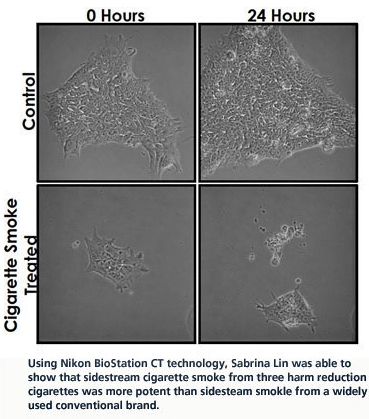Research Highlights
 "Harm Reduction" Cigarette’s Sidestream Smoke: More Toxic?
"Harm Reduction" Cigarette’s Sidestream Smoke: More Toxic?
Dr. Sabrina Lin at the University of California, Riverside has previously shown that sidestream cigarette smoke from three different brands of harm reduction cigarettes (Marlboro Lights, Advance Lights, and Quest Lights) is consistently more potent than sidestream smoke from a conventional brand (Marlboro Red).1
Now in a new study funded by TRDRP, Dr. Lin will provide further insight into why “harm reduction” cigarettes may be more toxic than conventional brands, providing evidence critical to countering tobacco industry marketing claims.
-
Sidestream smoke, which burns off the tip of a cigarette, is a mixture of 7,000 chemicals (Report of the Surgeon General, 2010), and is the major component of environmental tobacco smoke, which is also called secondhand smoke.
-
Exposure to sidestream smoke during pregnancy can cause adverse reproductive and embryo developmental effects, which include inability to conceive, spontaneous abortions, congenital defects, increased perinatal mortality, and lower birth weights.
With increasing numbers of reports showing health risks associated with tobacco usage, the general public has become interested in “harm reduction” cigarettes, such as Marlboro Gold, Advance Lights, and Quest Lights. These cigarettes are marketed as having lower levels of toxins. One brand’s ad (Advance Lights) declared that these cigarettes have “less of the toxins...and more of the taste.” Most analyses done on harm reduction cigarettes, however, have focused on mainstream smoke, which is actively inhaled by the smoker, and relatively little is known about the toxicity of sidestream smoke from these “harm reduction” products.
Surprisingly, Dr. Lin’s earlier studies using mouse and human embryonic stem cells as a model for early embryo development showed that sidestream smoke from “harm reduction” cigarettes adversely affected normal cellular  development. In addition, “harm reduction” sidestream smoke was more potent than sidestream smoke from a conventional brand (Marlboro Red). The chemical composition of sidestream smoke from “harm reduction” cigarettes, however, is not well characterized, and no comparisons have been made between “harm reduction” and conventional brands. In her new study, Dr. Lin hypothesizes that “harm reduction” sidestream smoke contains more and/or higher concentrations of toxicants than conventional brand cigarettes. The hypothesis will be tested in a series of experiments with human embryonic stem cells using novel bioassay technology combined with video bioinformatics tools. When complete, this study will have established a high-content biological assay system that examines a range of different cellular effects using video bioinformatics analysis. In addition, Dr. Lin will have identified the individual chemicals in sidestream smoke that have toxic effects on human embryonic stem cells and will have made comparisons between sidestream smoke from “harm reduction” and conventional cigarettes. This comparison will provide valuable insight into why “harm reduction” sidestream smoke appears to be more toxic than sidestream smoke from conventional brands.
development. In addition, “harm reduction” sidestream smoke was more potent than sidestream smoke from a conventional brand (Marlboro Red). The chemical composition of sidestream smoke from “harm reduction” cigarettes, however, is not well characterized, and no comparisons have been made between “harm reduction” and conventional brands. In her new study, Dr. Lin hypothesizes that “harm reduction” sidestream smoke contains more and/or higher concentrations of toxicants than conventional brand cigarettes. The hypothesis will be tested in a series of experiments with human embryonic stem cells using novel bioassay technology combined with video bioinformatics tools. When complete, this study will have established a high-content biological assay system that examines a range of different cellular effects using video bioinformatics analysis. In addition, Dr. Lin will have identified the individual chemicals in sidestream smoke that have toxic effects on human embryonic stem cells and will have made comparisons between sidestream smoke from “harm reduction” and conventional cigarettes. This comparison will provide valuable insight into why “harm reduction” sidestream smoke appears to be more toxic than sidestream smoke from conventional brands.
1Lin, S., Fonteno, S., Weng, J. H. and Talbot, P. (2010) Comparison of the toxicity of smoke from
conventional and harm reduction cigarettes using human embryonic stem cells. Toxicol Sci, 118, 202-
212.
13. Lin, S., Tran, V. and Talbot, P. (2009) Comparison of Toxicity of Smoke From Traditional and Harm
Reduction Cigarettes Using Embryonic Stem Cells as a Novel Model for Pre-Implantation Development.
Human Reproduction, 24, 386-397.
